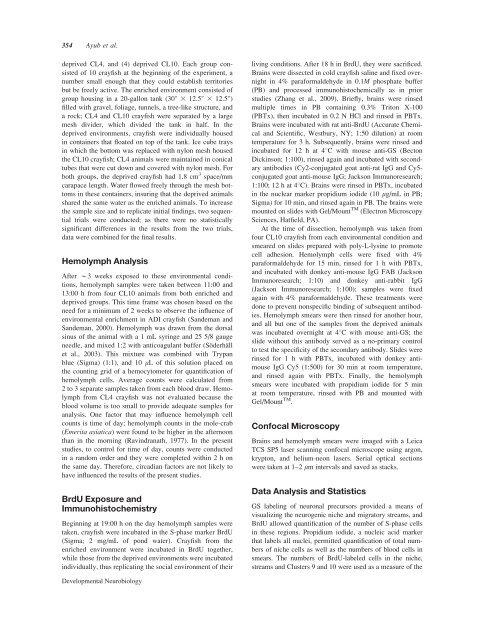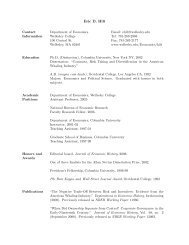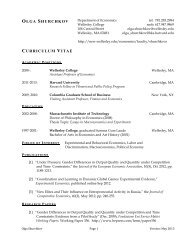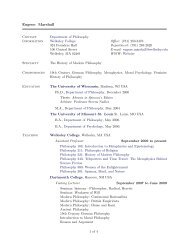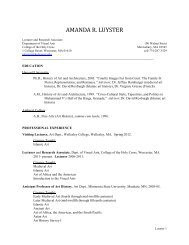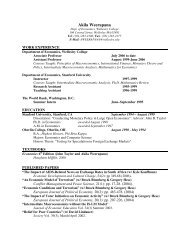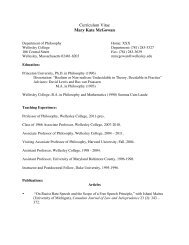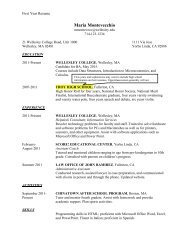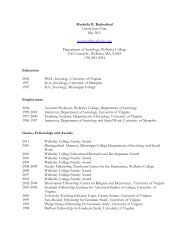PDF(575K) - Wiley Online Library
PDF(575K) - Wiley Online Library
PDF(575K) - Wiley Online Library
You also want an ePaper? Increase the reach of your titles
YUMPU automatically turns print PDFs into web optimized ePapers that Google loves.
354 Ayub et al.<br />
deprived CL4, and (4) deprived CL10. Each group consisted<br />
of 10 crayfish at the beginning of the experiment, a<br />
number small enough that they could establish territories<br />
but be freely active. The enriched environment consisted of<br />
group housing in a 20-gallon tank (30@ 3 12.5@ 3 12.5@)<br />
filled with gravel, foliage, tunnels, a tree-like structure, and<br />
a rock; CL4 and CL10 crayfish were separated by a large<br />
mesh divider, which divided the tank in half. In the<br />
deprived environments, crayfish were individually housed<br />
in containers that floated on top of the tank. Ice cube trays<br />
in which the bottom was replaced with nylon mesh housed<br />
the CL10 crayfish; CL4 animals were maintained in conical<br />
tubes that were cut down and covered with nylon mesh. For<br />
both groups, the deprived crayfish had 1.8 cm 3 space/mm<br />
carapace length. Water flowed freely through the mesh bottoms<br />
in these containers, insuring that the deprived animals<br />
shared the same water as the enriched animals. To increase<br />
the sample size and to replicate initial findings, two sequential<br />
trials were conducted; as there were no statistically<br />
significant differences in the results from the two trials,<br />
data were combined for the final results.<br />
Hemolymph Analysis<br />
After *3 weeks exposed to these environmental conditions,<br />
hemolymph samples were taken between 11:00 and<br />
13:00 h from four CL10 animals from both enriched and<br />
deprived groups. This time frame was chosen based on the<br />
need for a minimum of 2 weeks to observe the influence of<br />
environmental enrichment in ADI crayfish (Sandeman and<br />
Sandeman, 2000). Hemolymph was drawn from the dorsal<br />
sinus of the animal with a 1 mL syringe and 25 5/8 gauge<br />
needle, and mixed 1:2 with anticoagulant buffer (Söderhäll<br />
et al., 2003). This mixture was combined with Trypan<br />
blue (Sigma) (1:1), and 10 lL of this solution placed on<br />
the counting grid of a hemocytometer for quantification of<br />
hemolymph cells. Average counts were calculated from<br />
2 to 3 separate samples taken from each blood draw. Hemolymph<br />
from CL4 crayfish was not evaluated because the<br />
blood volume is too small to provide adequate samples for<br />
analysis. One factor that may influence hemolymph cell<br />
counts is time of day; hemolymph counts in the mole-crab<br />
(Emerita asiatica) were found to be higher in the afternoon<br />
than in the morning (Ravindranath, 1977). In the present<br />
studies, to control for time of day, counts were conducted<br />
in a random order and they were completed within 2 h on<br />
the same day. Therefore, circadian factors are not likely to<br />
have influenced the results of the present studies.<br />
BrdU Exposure and<br />
Immunohistochemistry<br />
Beginning at 19:00 h on the day hemolymph samples were<br />
taken, crayfish were incubated in the S-phase marker BrdU<br />
(Sigma; 2 mg/mL of pond water). Crayfish from the<br />
enriched environment were incubated in BrdU together,<br />
while those from the deprived environments were incubated<br />
individually, thus replicating the social environment of their<br />
Developmental Neurobiology<br />
living conditions. After 18 h in BrdU, they were sacrificed.<br />
Brains were dissected in cold crayfish saline and fixed overnight<br />
in 4% paraformaldehyde in 0.1M phosphate buffer<br />
(PB) and processed immunohistochemically as in prior<br />
studies (Zhang et al., 2009). Briefly, brains were rinsed<br />
multiple times in PB containing 0.3% Triton X-100<br />
(PBTx), then incubated in 0.2 N HCl and rinsed in PBTx.<br />
Brains were incubated with rat anti-BrdU (Accurate Chemical<br />
and Scientific, Westbury, NY; 1:50 dilution) at room<br />
temperature for 3 h. Subsequently, brains were rinsed and<br />
incubated for 12 h at 48C with mouse anti-GS (Becton<br />
Dickinson; 1:100), rinsed again and incubated with secondary<br />
antibodies (Cy2-conjugated goat anti-rat IgG and Cy5conjugated<br />
goat anti-mouse IgG; Jackson Immunoresearch;<br />
1:100; 12 h at 48C). Brains were rinsed in PBTx, incubated<br />
in the nuclear marker propidium iodide (10 lg/mL in PB;<br />
Sigma) for 10 min, and rinsed again in PB. The brains were<br />
mounted on slides with Gel/Mount TM (Electron Microscopy<br />
Sciences, Hatfield, PA).<br />
At the time of dissection, hemolymph was taken from<br />
four CL10 crayfish from each environmental condition and<br />
smeared on slides prepared with poly-L-lysine to promote<br />
cell adhesion. Hemolymph cells were fixed with 4%<br />
paraformaldehyde for 15 min, rinsed for 1 h with PBTx,<br />
and incubated with donkey anti-mouse IgG FAB (Jackson<br />
Immunoresearch; 1:10) and donkey anti-rabbit IgG<br />
(Jackson Immunoresearch; 1:100); samples were fixed<br />
again with 4% paraformaldehyde. These treatments were<br />
done to prevent nonspecific binding of subsequent antibodies.<br />
Hemolymph smears were then rinsed for another hour,<br />
and all but one of the samples from the deprived animals<br />
was incubated overnight at 48C with mouse anti-GS; the<br />
slide without this antibody served as a no-primary control<br />
to test the specificity of the secondary antibody. Slides were<br />
rinsed for 1 h with PBTx, incubated with donkey antimouse<br />
IgG Cy5 (1:500) for 30 min at room temperature,<br />
and rinsed again with PBTx. Finally, the hemolymph<br />
smears were incubated with propidium iodide for 5 min<br />
at room temperature, rinsed with PB and mounted with<br />
Gel/Mount TM .<br />
Confocal Microscopy<br />
Brains and hemolymph smears were imaged with a Leica<br />
TCS SP5 laser scanning confocal microscope using argon,<br />
krypton, and helium-neon lasers. Serial optical sections<br />
were taken at 1–2 lm intervals and saved as stacks.<br />
Data Analysis and Statistics<br />
GS labeling of neuronal precursors provided a means of<br />
visualizing the neurogenic niche and migratory streams, and<br />
BrdU allowed quantification of the number of S-phase cells<br />
in these regions. Propidium iodide, a nucleic acid marker<br />
that labels all nuclei, permitted quantification of total numbers<br />
of niche cells as well as the numbers of blood cells in<br />
smears. The numbers of BrdU-labeled cells in the niche,<br />
streams and Clusters 9 and 10 were used as a measure of the


